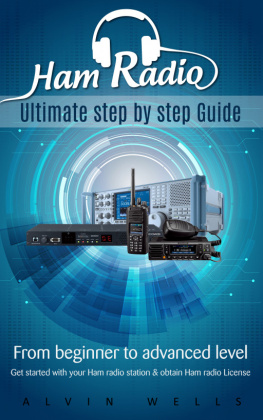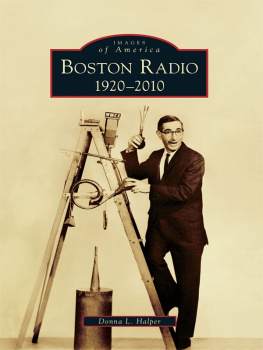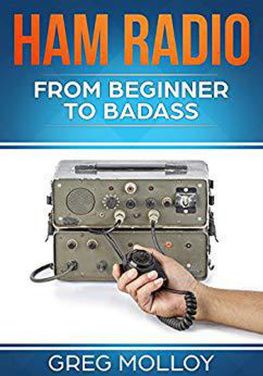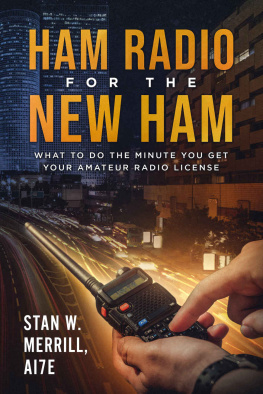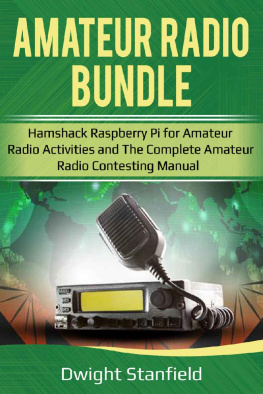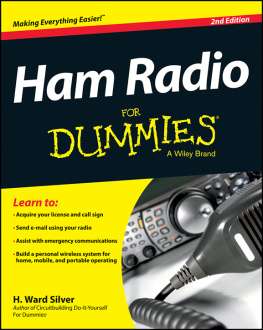Ham Radio: Ultimate Step by Step Guide
From Beginner to Advanced Level: Get StartedWith Your Ham Radio Station & Obtain Ham Radio License
By Alvin Wells
2018
All Rights Reserved
No Unauthorized Reproduction Without ThePublisher's Written Permission
Sign up to get news about new releases, freeand discounted Ebooks!
http://books.readerschoice.club
Table of contents
Troubleshooting advice to quicklysolve the most common problems new hams strugglewith.
Ham radio Problem #1: Your Radio May refuseto Turn On
Ham radio Problem #2:Beeping
Ham radio Problem #3: Static
Choosing your first hamradio
Handhelds
Mobile or Mobile/Base
Mono Band, Dual Band, or MultiBand
Memories andprogramming
Everything you need to set up yourfirst station
Antenna
Handheld Walkie
Power supply
Antenna tuner
Call signs and modes
Morse Code
Voice Modes
Image Modes
Weak Signal Modes
Renewal of Call Signs
Make internationalfriends
Train with cool technology
Understand what happens ondifferent bands and learn to tune in a signal on SSB, FM, HF, VHF,and UHF
Medium frequency
High frequency
Assist with emergencycommunications
The effect of solar and weather conditions onradio waves
The future of ham radio
Introduction
Hams Radio is very simple in its operation.It usually depends on radio waves to get the message out. It uses avariety of radio frequencies, which non-hams can hear the messagebeing transmitted via their scanners or receivers, though youcannot participate in the action without a license or atransmitter. A ham operator can only use a specific radio frequencyto transmit the frequencies, which is allocated by the FCC foramateur use.
How to acquireyour license
The question most people ask themselves, isham license really needed for someone to operate a ham radio? Well,the answer is yes, it is required by the Federal CommunicationsCommission (FCC). As a matter of fact, there are very stiffpenalties for anyone who would operate a ham radio frequencieswithout a license.
Another question people ask themselves, whyis ham licenses required? You can rest assured its not so that thegovernment can get rich collecting fees. Ham license fees are quitereasonable.
Follow these steps if you want to get yourlicense .
Before one receives a license, he/she mustpass an exam that is administered by a team of volunteer examiners(VEs). The body determines the license operator class for which oneis qualified through testing his /her abilities and skills inoperating a ham station.
You can contact Volunteer Examiners in yourcommunity so that you make arrangements for being administered withthe examination elements. In case you want assistance in finding VEin your town, contact Volunteer Examiner Coordinator (VEC).
Once you have completed the examsuccessfully, the Volunteer Examiner Coordinator collects your Form605 from your Volunteer Examiners and after they have screened itcarefully, they forward the information to the FCC forprocessing.
Your operating authority starts when your hamlicense information appears on the database of amateur servicelicensee of the Universal Licensing System.
Sources for hamexam
One of the best sources concerning ham radiolicense exam can be found at the American Radio Relay League(ARRL). It is a national organization for ham radio. Why you shouldsearch for ARRL site is because it has listed all the ham radiolicense exams (times, locations, check-in procedures, etc.). Thesite also contains beautiful graphic charts of what specific modeand frequencies FCC ham radio licenses classes are permitted tooperate on. It is quite valuable and free in day to day use, and itcan also be used as a study guide.
Threeprimary levels of ham radio licenses .
The first one is the technician, which is the basicand low power.
The second one is the general, which has morefrequencies and power.
The last one is the extra that highest power and mostfrequencies are allowed.
How to obtain yourCall sign
You can get vanity call sign using either FCCForm 159 and FCC Form 605 Schedule D or the Universal LicensingSystem. The fee to be paid for vanity call sign is usually reviewedevery year as part of commissions regulatory structure.
There are up to 3 different request typesthat you can use to request for vanity call signs; it depends ifthe call sign is to apply to a club or primary station. You canrequest up to 25 call signs in order of preference. The specificprefix, suffix, and numeral must be given for each call sign. Anyrequest stated in general terms like "Any call sign having thesuffix/prefix or Any call sign with my initials.." willautomatically be dismissed.
Once you have applied, you can start watchingthe FCC database for your new call sign to appear. This is usuallyafter you have completed all the paperwork and they have been sentto VEC and you have also completed the test session. If it issuccessful, your call sign will appear in the FCC database withyour name besides it.
All aboutantennas
There are varying types of amateur radioantennas since operators of ham radio usually have many bands and alot of thousands of possible frequencies they can use for two-wayradio communication.
Several hams these days require an operatorto pass a simple examination that allows them to easily start ahobby with a VHF portable radio, which mostly work in 2-meter band.These two-meter transceivers transmit at about 146 MHZ, therefore,a small antenna works better for them.
Some amateur radio operators enjoy theadvantage and excitement of long-range radio, thereby taking overthe short waves of other hams around the area, in other cities orin other nations. It is therefore only appropriate to go for anamateur radio antenna, which is much bigger since radio signalsvibrate at a lower (or longer) frequency. A transmitting antennamostly needs to match or resonate the frequency of the signal it issending.
As you can see, ham radio antennas forshortwaves bands are different and vary from wire aerials, whichare more than two hundred feet long to around sixty-six feet or so.While towers or vertical antennas can go up to around forty feet ormore straight up in the atmosphere. All these two-way radio aerialshave varying weaknesses and strengths in store.
There are certain amateur radio antennas,which are good for long-range work; others are excellent for shortrange or for portable or mobile use. There is also beam antennasthat suppress their signals and concentrate their power in onedirection at their sides and back. Beam antennas require beingmounted on a tower or a mast so that they can easily be rotated andaimed in whichever direction that is required that day.
There are three major design for beamantennas. These are broadband long periodic dipole antennas, quadantennas, and yagi antennas. Yagi antennas can be single ormulti-band designs, and may be HF, UHF or VHF. The 14 MHz, which is20 M band is mostly the lowest ham band; it usually covers 4 or 3band yagi designs.
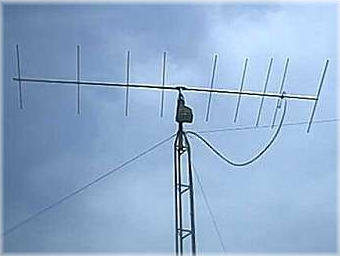
Quad antenna
When it comes to Quad antennas on the HFbands, it mostly has two elements and it can be multi-banded. Thereare spinder quad and cubical quads designs. You should take notethat when it comes to VHF bands, a quad antenna is usually smallerthan HF, so it can have four elements. However, yagis are the mostcommon for UHF and VHF bands. On the side of HF band, log periodicantennas are really large; this is some of the reason why they aremost common to the military and government embassies. If you have agood capital, this is one of the best antennas to go for.

